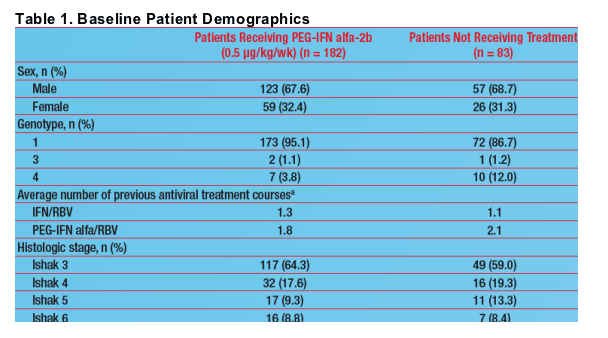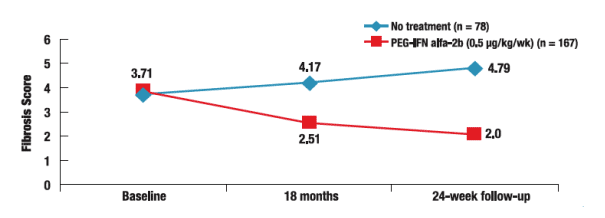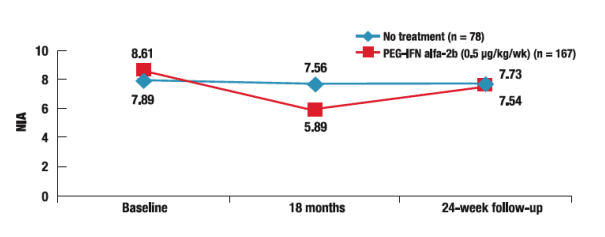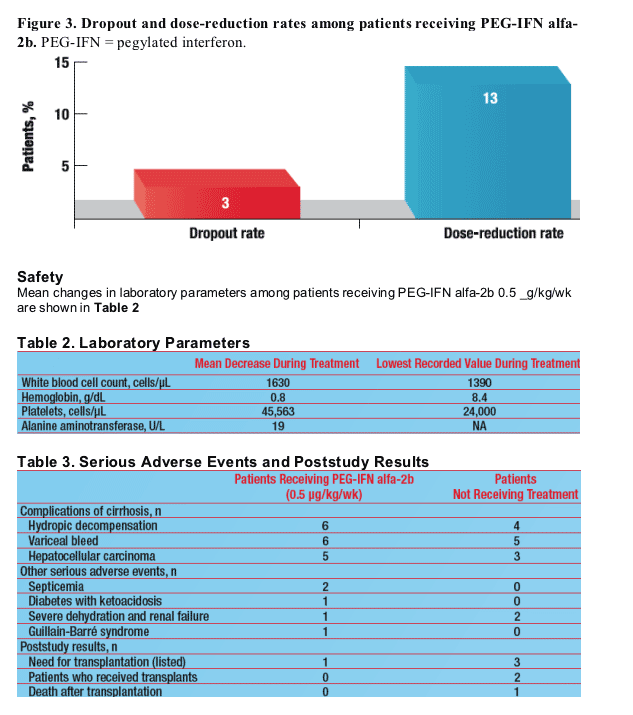 |
 |
 |
| |
Long-Term, Low-Dose Treatment With Pegylated Interferon alfa-2b Leads to a Significant Reduction in Fibrosis and Inflammatory Scores in Chronic Hepatitis C Nonresponder Patients With Fibrosis or Cirrhosis
|
| |
| |
Reported by Jules Levin
Nov 2-6, 2007, AASLD, Boston, MA
S. Kaiser,1 B. Lutze,2 B. Sauter,1 L. Bissinger,1 C. Werner,1 H. Hass,2 M. Gregor1
1Department of Medicine I, University Hospital of Tuebingen, Tuebingen, Germany; 2Department of Hematology and Oncology, Marienhospital, Stuttgart, Germany
Author Summary
Low-dose therapy with PEG-IFN alfa-2b in patients with chronic hepatitis C and advanced fibrosis or cirrhosis, compared with untreated patients, results in a significant and persistent decrease in fibrosis
Temporary improvement in NIA was also observed during treatment with PEG-IFN alfa-2b, but NIA returned to baseline levels after treatment withdrawal
Treatment with PEG-IFN alfa-2b was well tolerated
Author Conclusion
Low-dose PEG-IFN alfa-2b monotherapy may be a suitable salvage therapy for patients with chronic hepatitis C and advanced liver disease for whom standard antiviral therapy has failed
ABSTRACT
Objective: Treatment with current standard antiviral therapy leaves about 50% of patients without viral clearance with the risk of progression of their liver disease. Recent studies have suggested an antifibrotic effect of low-dose interferon treatment.
Methods: The efficacy of low-dose pegylated interferon alfa-2b with 0.5 _g/kg weekly given for 36 months as monotherapy was evaluated based on histological examination and liver function in 182 patients with chronic HCV, nonresponse to
antiviral combination therapy and significant fibrosis/cirrhosis (Ishak staging 3-6) and compared to an observational control group (n = 83). Histology was evaluated at baseline, at 18 months of treatment, and 6 months after end of treatment.
Results:
At 18 months' therapy, an increase in fibrosis score from 3.71 to 4.17 and at 6 months post-observation to 4.79 was detectable in the control group (n = 78). In the treatment group, a decrease from 3.83 at baseline to 2.51 at 18 months and 2.05 at 6 months posttherapy was noted (n = 167).
The necroinflammatory score showed constant levels, with 7.89 at baseline, 7.56 at month 18, and 7.73 at 6 months postobservation in the control group. In the treatment group, the score decreased from 8.61 at baseline to 5.89 at month 18 and then relapsed again to 7.54 posttherapy. 61% of patients in the treatment group showed an HCV viral load decline of >1 log10, and 6% had a negative PCR, which, however, was not maintained for any patient upon cessation of therapy.
The dropout rate was 3% and the dose reduction rate was 13%. 22 SAEs were observed, of which 17 were complications of cirrhosis (6 hydropic decompensations, 6 variceal bleeds, and 5 HCC development). There was no significant difference in these complications between treatment and observational groups.
Conclusions: Low-dose therapy with pegylated interferon alfa-2b in patients with HCV and advanced fibrosis or cirrhosis shows a significant and persistent decrease in fibrosis in comparison to a control group. In contrast, the also observed significant decrease in the necroinflammatory score is only temporary as long as treatment lasts. As treatment was well tolerated even for patients with cirrhosis, this treatment could evolve as a salvage therapy for patients with advanced liver disease with HCV where standard antiviral therapy has failed.
Background
Eradication of hepatitis C virus (HCV) is the primary treatment goal for patients with chronic hepatitis C; however, overall, only approximately 50% of patients respond to current standard-of-care treatment: pegylated interferon (PEG-IFN) alfa plus ribavirin (RBV)
Chronic hepatitis C patients with advanced liver fibrosis or cirrhosis are among the most difficult to treat; SVR rates of approximately 22% are reported among patients with cirrhosis receiving IFN-based antiviral therapy1
PEG-IFN alfa plus RBV reduces or stabilizes the progression of fibrosis and improves necroinflammatory activity (NIA) in patients with chronic hepatitis C, even in the absence of viral eradication2
Maintenance therapy using IFN monotherapy (5 million units [MU] 3 times a week for 24 months) has a beneficial effect on hepatic histology in patients who previously did not attain undetectable HCV RNA after 24 weeks of treatment
with IFN plus RBV3
Chronic hepatitis C patients with bridging fibrosis or cirrhosis are predisposed to certain toxicities associated with PEG-IFN alfa therapy, including neutropenia and thrombocytopenia4
It is critical to establish the minimally effective dose of PEG-IFN alfa for use as maintenance therapy to maximize improvement in liver histology and minimize the risk for adverse tolerability
Aim
To evaluate the efficacy and safety of low-dose PEG-IFN alfa-2b (PegIntron®) as maintenance therapy in patients with chronic hepatitis C and advanced fibrosis or cirrhosis
Methods
Patients
Patients with chronic hepatitis C who were previous nonresponders to antiviral therapy and who had advanced fibrosis/cirrhosis (Ishak staging 3-6) were enrolled
Patients received low-dose PEG-IFN alfa-2b (0.5 _g/kg/wk) monotherapy (treated patients) for 36 months or no therapy (untreated patients) during a 36-month observation period
Assessments
Histology and liver function were compared in treated and untreated patients
-- Histology was evaluated by liver biopsy at baseline, at 18 months of treatment, and at 24 weeks after end of treatment (treated patients) or after a 36-month observational period (untreated patients)
-- Histologic grading and staging were quantified according to the Ishak criteria
Results
Baseline Patient Demographics
182 Patients receiving treatment were enrolled in the study, and 167 patients were included in the analysis
-- Although all patients have completed therapy, 15 patients have not undergone a second liver biopsy
An additional 83 untreated patients were enrolled to serve as an observational cohort
Baseline patient demographics are shown in Table 1

aPatients were previously treated with IFN (5-6 MU 3 times weekly for 3 months, then 3 MU 3 times weekly) plus RBV (1000-1200 mg/d depending on body weight), PEG-IFN alfa-2a (180 _g/wk) plus RBV (1000-1200 mg/d depending on body weight), or PEG-IFN alfa-2b (1.5 _g/kg/wk) plus RBV (11 mg/kg) for at least 24 weeks.
Fibrosis Scores
Mean fibrosis scores improved during treatment and were maintained 24 weeks after cessation of treatment in patients receiving PEG-IFN alfa-2b 0.5 _g/kg/wk (Figure 1) NOTE from Jules: the graph in figure 1 shows at week 24 followup firbosis improvement was maintained but you can't tell how long improvement lasts since followup ends at week 24.
In contrast, fibrosis scores slowly increased in untreated patients (indicating a progressive deterioration in liver histology) during the 36-month observational period and throughout follow-up
Figure 1. Fibrosis scores in treated and untreated patients at baseline, after 18 months, and at follow-up (24 weeks after cessation of treatment [treated patients] or after a 36-month observational period [untreated patients]).
PEG-IFN = pegylated interferon.

Necroinflammatory Activity
NIA decreased during treatment but returned to baseline levels at follow-up in patients receiving PEG-IFN alfa-2b 0.5 _g/kg/wk (Figure 2)
NIA remained relatively stable during the 36-month observational and follow-up periods in untreated patients
Figure 2. NIA in treated and untreated patients at baseline, after 18 months, and at follow-up (24 weeks after cessation of treatment [treated patients] or after a 36-month observational period [untreated patients]).
NIA = necroinflammatory activity; PEG-IFN = pegylated interferon.

HCV RNA Levels, Dropout Rates, and Discontinuation Rates
Overall, 61% of treated patients experienced a >1 log10 decrease in HCV RNA from baseline during treatment
-- In 10 (6%) of 167 patients, HCV RNA was undetectable at the end of treatment-- All patients who received PEG-IFN alfa-2b 0.5 _g/kg/wk experienced relapse after withdrawal of treatment
Among treated patients, dropout and dose-reduction rates were 3% and 13%, respectively (Figure 3)

References
1. Everson GT. Clin Gastroenterol Hepatol. 2005;3:S106-S112.
2. Poynard T et al. Gastroenterology. 2002;122:1303-1313.
3. Shiffman ML et al. Gastroenterology. 1999;117:1164-1172.
4. Fontana RJ et al. Clin Gastroenterol Hepatol. 2004;2:183-197.
|
| |
|
 |
 |
|
|